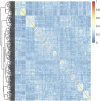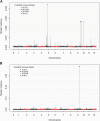Genomic Selection for Late Blight and Common Scab Resistance in Tetraploid Potato (Solanum tuberosum)
- PMID: 29794167
- PMCID: PMC6027896
- DOI: 10.1534/g3.118.200273
Genomic Selection for Late Blight and Common Scab Resistance in Tetraploid Potato (Solanum tuberosum)
Abstract
Potato (Solanum tuberosum) is a staple food crop and is considered one of the main sources of carbohydrates worldwide. Late blight (Phytophthora infestans) and common scab (Streptomyces scabies) are two of the primary production constraints faced by potato farming. Previous studies have identified a few resistance genes for both late blight and common scab; however, these genes explain only a limited fraction of the heritability of these diseases. Genomic selection has been demonstrated to be an effective methodology for breeding value prediction in many major crops (e.g., maize and wheat). However, the technology has received little attention in potato breeding. We present the first genomic selection study involving late blight and common scab in tetraploid potato. Our data involves 4,110 (Single Nucleotide Polymorphisms, SNPs) and phenotypic field evaluations for late blight (n=1,763) and common scab (n=3,885) collected in seven and nine years, respectively. We report moderately high genomic heritability estimates (0.46 ± 0.04 and 0.45 ± 0.017, for late blight and common scab, respectively). The extent of genotype-by-year interaction was high for late blight and low for common scab. Our assessment of prediction accuracy demonstrates the applicability of genomic prediction for tetraploid potato breeding. For both traits, we found that more than 90% of the genetic variance could be captured with an additive model. For common scab, the highest prediction accuracy was achieved using an additive model. For late blight, small but statistically significant gains in prediction accuracy were achieved using a model that accounted for both additive and dominance effects. Using whole-genome regression models we identified SNPs located in previously reported hotspots regions for late blight, on genes associated with systemic disease resistance responses, and a new locus located in a WRKY transcription factor for common scab.
Keywords: BGLR; Bayesian; Common scab; Disease resistance; Genome-Wide Regression; Genomic Selection; Late blight; Polyploidy; Potato.
Copyright © 2018 Enciso-Rodriguez et al.
Figures




References
-
- Ahn Y. K., Park T.-H., 2013. Resistance to common scab developed by somatic hybrids between Solanum brevidens and Solanum tuberosum. Acta Agriculturae Scandinavica, Section B - Soil &. Plant Sci. 63: 595–603.
-
- Barone A., 2004. Molecular Marker-assisted Selection for Potato Breeding. Am. J. Potato Res. 81: 111–117. 10.1007/BF02853608 - DOI
Publication types
MeSH terms
Grants and funding
LinkOut - more resources
Full Text Sources
Other Literature Sources
